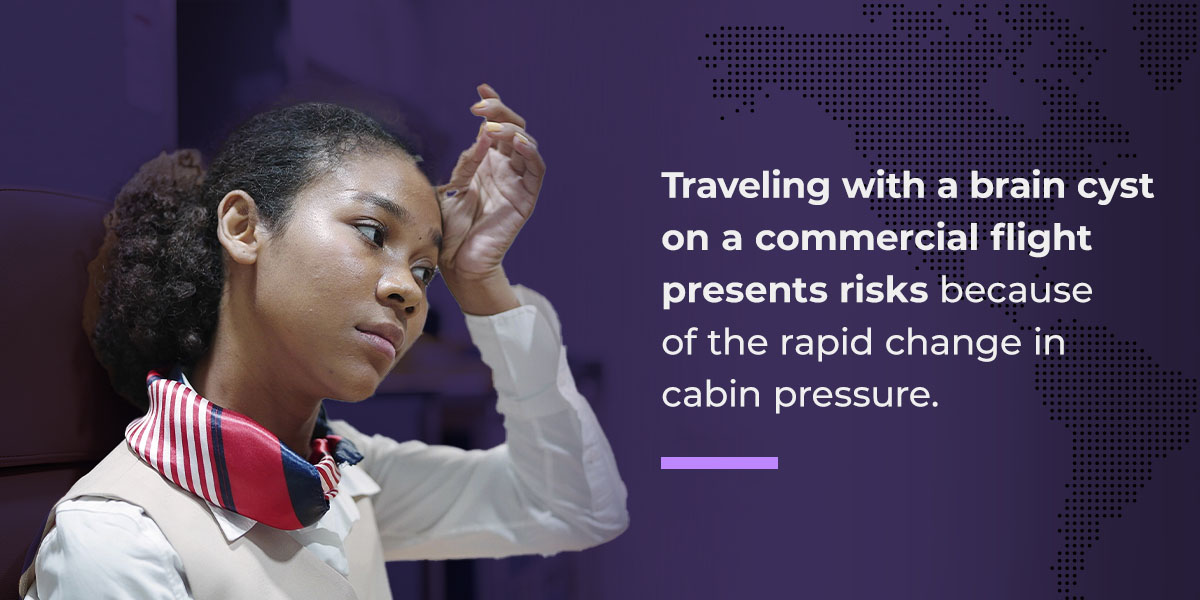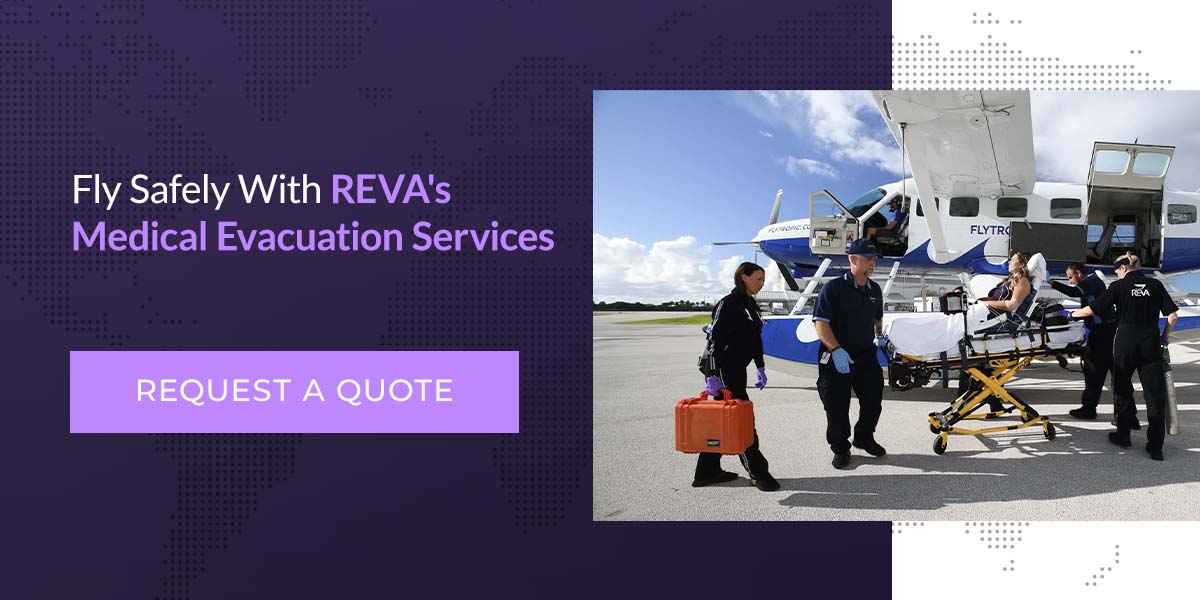Flying on a commercial aircraft with a cyst on your brain presents potential risks. A commercial flight’s cabin pressure can worsen a brain cyst, causing complications such as seizures, brain injuries, coma and death. Fortunately, an air ambulance flight significantly reduces cyst-related complications, allowing you to fly in a pressure-controlled cabin with an experienced medical team.
Learn more about the types of brain cysts and how you can fly safely with a brain cyst.
What Are Brain Cysts?
A brain cyst is a fluid-filled lesion in the brain. It’s a sac typically containing pus, blood and other fluids such as cerebrospinal fluid (CSF). Brain cysts are most often non-cancerous, and they can occur in individuals of all ages. Non-cancerous or benign cysts do not spread to other areas in the brain or body, but cancerous or malignant cysts do.
Brain Cyst Types
Different types of brain cysts develop in different areas of the brain. An individual can develop any of the following types of cysts:
- Epidermoid: An epidermoid cyst is a tumor that forms from skin tissue that becomes trapped when the spinal cord and brain form before birth. Epidermoid cysts grow slowly and lack hair follicle cells and sweat glands. They primarily develop during adulthood.
- Dermoid: Similar to an epidermoid cyst, a dermoid cyst also forms from skin tissue that becomes trapped when the brain and spinal cord develop. Dermoid cysts can contain sweat gland or hair follicle cells. These cysts are rare, and about 70% of dermoid cyst cases are found in children 5 or younger.
- Colloid: A colloid cyst is gel-filled and typically forms in one of the brain’s four ventricles. Colloid cysts usually appear during adulthood, and they can cause positional headaches because they block the drainage of CSF.
- Pineal: A pineal cyst develops in the brain’s pineal gland, and it can occur at any age. Pineal cysts rarely cause complications unless are large and affect an individual’s vision.
- Arachnoid: An arachnoid cyst develops between the brain and its protective arachnoid membrane.
- Metastatic: A metastatic cyst is a cancerous tumor that begins developing outside the brain.
Recognizing the Symptoms
A brain cyst can cause one or all of the following symptoms:
- Seizures
- Dizziness
- Headaches or facial pain
- Difficulty walking or maintaining balance
- Vision or hearing complications
- Nausea and vomiting
While some people experience symptoms when they have a brain cyst, many cases are asymptomatic. Without symptoms, some people unknowingly live with a brain cyst for years until it appears on an imaging scan they receive for other medical reasons.
How Do Medical Professionals Treat Brain Cysts?
Small, benign brain cysts typically don’t require surgery or treatment because they remain the same size. If you have an asymptomatic benign cyst, your doctor may recommend periodic scans to ensure it doesn’t become cancerous or increase in size. However, larger cysts may require surgical removal if they cause symptoms by pressing against the brain’s tissue. Additionally, a cancerous cyst requires surgery to prevent it from growing and spreading.
Can You Fly With a Cyst on the Brain?
You can fly with a brain cyst with your doctor’s approval and the proper onboard medical support. The size, location and type of cyst a person has changes the way it affects the brain and body, so seeking your doctor’s medical advice before flying is crucial.
Why Flying With a Brain Cyst Requires Medical Support
Traveling with a brain cyst on a commercial flight presents risks because of the rapid change in cabin pressure. A commercial flight’s air pressure is significantly lower than ground-level pressure, causing slight changes in the body. When a person is in a low-pressure environment, fluid and air accumulations in their body can expand and worsen a brain cyst.
The lower cabin pressure can quickly increase their intracranial pressure, which increases the risk of the following complications:
- Coma
- Seizure
- Brain injury
- Death
Brain cysts are unpredictable because the brain is complex. One person with a cyst may experience a minor headache on a flight, but another may experience a seizure, lose consciousness or develop neurological damage. The safest option is to fly on a medical evacuation flight that can ensure your safety during transport.
Do Individuals Experience Complications After Flying With a Brain Cyst?
While brain cyst complications following a flight are uncommon, there are reports of deteriorating consciousness and death. With this slight chance of health complications, booking a safe flight with the proper medical care is essential.
Can You Fly After a Brain Operation?
If you have a surgical brain cyst removal, you should avoid flying until your doctor approves it as safe. Air can become trapped in the cranial cavity during a surgical procedure, and low cabin pressure can expand the trapped air.
How to Fly Safely With a Brain Cyst
You can fly safely with a brain cyst by consulting with your doctor before traveling and booking a reliable medical flight. With proper medical support, you can reach your destination with peace of mind. An air ambulance flight is the safest way to fly with a brain cyst because it offers the following benefits:
- Expert medical care: Air ambulances are private aircraft fully equipped with medical equipment and experienced medical personnel. An air ambulance’s medical team consists of highly trained professionals who can prevent and handle medical emergencies.
- Safe travel: An air ambulance team also includes an experienced flight crew. Pilots and cabin crew members follow strict policies and regulations to ensure safe transportation.
- Sea-level flights: An air ambulance company can transport a patient via a sea-level flight. During a sea-level flight, the pilot and crew modify the cabin pressure at high altitudes to match ground-level pressure. This significantly reduces the risk of a brain cyst worsening and increasing intracranial pressure.
REVA Medical Evacuation Flights
REVA’s medical evacuation flights provide necessary medical care and fly with sea-level cabin pressure to help prevent brain cyst complications. From documentation and speaking with your insurance to picking you up from the hospital, we offer bed-to-bed medical air transportation to take you where you need to go. Whether you live abroad or are on an international trip, we can help you reach a high-quality hospital in your home country.
Fly Safely With REVA’s Medical Evacuation Services
A commercial flight can worsen a brain cyst and result in serious health complications, but a private air ambulance provides the proper medical support and cabin pressure for safe travel. Medical flights keep you safe and comfortable while transporting you. When you book an air ambulance, medical professionals monitor you closely to prevent complications, and they can address any medical needs that arise.
REVA provides medical evacuation services you can depend on. Our medical teams receive frequent training to ensure they can provide the highest quality care, and our flight crews meet strict regulations to transport you securely. We offer sea-level flights so you can travel in a pressure-controlled cabin to prevent neurological complications during transport, and we provide bed-to-bed transport for smooth hospital transfers.
Contact REVA to request a quote and learn more about medical evacuation flights.



